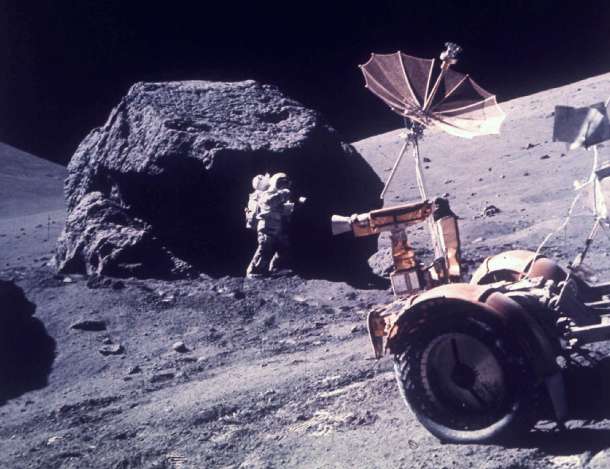This content has been archived. It may no longer be relevant

A trove of rare moon rocks, preserved untouched for nearly half a century, will be unsealed by Bay Area scientists this summer and used for experiments that NASA hopes will solve lingering mysteries about the lunar surface and pave the way for future habitation of Earth’s natural satellite.
Nine research teams, including two at NASA Ames Research Center in Mountain View and one at UC Berkeley, were selected this month to conduct high-tech studies of a special collection of rocks that astronauts dug up during the last Apollo mission in 1972 and placed in hermetically sealed containers.
The rocks, which have never been exposed to Earth’s atmosphere, will undergo a variety of tests that will help scientists identify elements and pinpoint places on the lunar surface that could be useful for humans on future missions. The ultimate goal is to locate and squeeze out water, mine materials and use the moon as a jumping-off point for expeditions to other planets.
The selected teams are gathering at the Johnson Space Center in Houston, where the samples are stored, to make plans and begin coordinating activities and logistics before beginning the experiments this summer. Each team will have a share of the $8 million awarded by NASA to conduct its research.
The moon rock research is possible only because NASA had the foresight nearly a half century ago to put core samples in vacuum-sealed canisters or helium vessels, or store them frozen at minus 30 Celsius (minus 22 Fahrenheit), to create what are essentially lunar time capsules.
The samples will be divvied up from 1.8 pounds of material collected by astronauts Harrison Schmitt and Gene Cernan during the Apollo 17 mission in 1972, the last manned mission to the familiar sphere gracing Earth’s night sky.
“In the early ’70s, the state of technology wasn’t what it is right now,” Sehlke said. “Now we are able to do much more sophisticated analysis. The idea was to save the samples for future generations to study by protecting them from interacting with air, oxygen, nitrogen or other materials not on the moon.”
The two teams at NASA Ames will use the rocks to calculate the thermal history of the lunar surface and determine the impact of solar wind and radiation on the moon’s basic elements.
The experiments will, by necessity, be limited. Sehlke’s team will receive 15 frozen packets, containing a total of only 1.5 grams of rock, less than a teaspoon full. It is consequently very important to extract as much data as possible from every morsel, he said.
Sehlke’s plan is to heat the grains to 400 to 500 degrees Celsius (752 to 932 degrees Fahrenheit) and measure thermoluminescence, essentially the light intensity emitted by the rock. The technique will help researchers figure out the maximum temperature the rock was exposed to on the lunar surface since it was created out of a molten stew.
The other Mountain View group, led by Richard Walroth of the Universities Space Research Association and David Blake of Ames, will use a stratified core sample stored in a vacuum-sealed “drive tube” to determine how the solar wind — made up of charged particles carrying hydrogen from the sun — impacts iron and other metals on the moon.
The UC Berkeley team, led by Kees Welten, an associate research chemist at the university’s Space Sciences Laboratory, will use two tablespoons of material to study how cosmic rays, along with the impacts of meteorites and micrometeorites, affected the geology of the lunar surface.
The Complete Article
Peter Fimrite is a San Francisco Chronicle staff writer. Email: pfimrite@sfchronicle.com Twitter: @pfimrite

